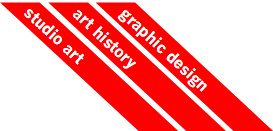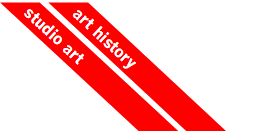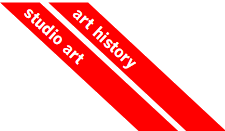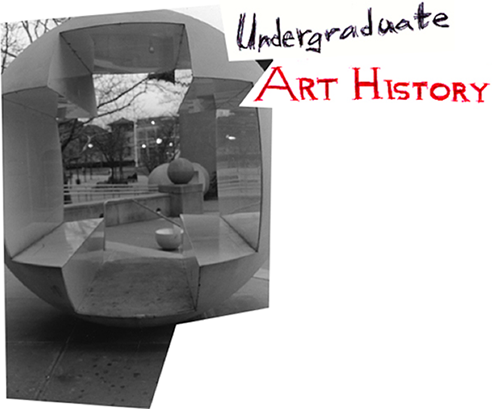|
|
Courses
ARTH 001 Introduction to Art. 3 hr.; 3 cr.
An introduction to art, dealing with the basic concepts of painting, sculpture, and architecture and their formal, symbolic, and expressive functions.
ARTH 101 History of Western Art I. 3hr.; 3 cr.
A survey of the history of Western art, studied in historical sequence and in greater depth than in Art 1.
ARTH 102 History Western Art II. 3hr.; 3 cr.
A survey of the history of Western art, studied in historical sequence and in greater depth than in Art 1.
ARTH 110 Survey of Ancient Art. 3 hr., 3 cr.
The art and architecture of ancient Greece and Rome, from the Minoan and Mycenaean periods until the late Roman Empire in the fourth century C.E. Covers this time span in chronological order, with some emphasis on the monuments of the Classical and Hellenistic Greek periods, and the Early to High Roman Imperial periods. (H2, PN)
ARTH 111 Survey of Medieval Art. 3 hr.; 3 cr.
An introduction to the art of the European Middle Ages from its beginnings in pre-Christian Celtic art through Carolingian and Romanesque art and the art of the great Gothic cathedrals. (H2, PN)
ARTH 112 Survey of Renaissance and Baroque Art.
3 hr.; 3 cr. An introduction to the painting, sculpture, and architecture of western Europe from 1300 to 1750. Major figures and cultural ideals of the early modern period, from Giotto to Leonardo da Vinci, Michelangelo, Bernini, Caravaggio, and Rembrandt. (H2, PN)
ARTH 113 Survey of Modern Art. 3 hr.; 3 cr.
Western art from the late eighteenth century to the present, with attention to the dramatic social, technological, and intellectual changes of modern life that set its painting, sculpture, architecture, and other art forms apart from earlier, pre-industrial times. Artists covered range from the Romantics to the Impressionists to van Gogh and Picasso. (H2)
ARTH 114 Survey of Asian Art. 3 hr.; 3 cr.
A comparative study of the artistic traditions of India, China and Japan, from their Stone Age beginnings to
recent trends. Focus on the relationship of works of
art to the philosophies of Confucianism, Buddhism,
and Taoism. (H2, PN)
ARTH 115 Principles of Architecture. 3 hr.; 3 cr.
Analysis of the varieties of architectural space formation, the techniques used to achieve them and the resulting meanings encoded in a selected series of worldwide examples. The course may require several field trips to appropriate examples of space types available in metro New York. (H2)
ARTH 203 Art and Archaeology of the Ancient Near East.
3 hr.; 3 cr. The art and architecture of the ancient Near East, focusing on Mesopotamia and Syria-Palestine ("the Fertile Crescent"). Civilizations studied include the Sumerians, Akkadians, Babylonians, Hittites, Assyrians, and Persians, all of which contributed greatly to the growth of later Western culture. Archaeological evidence is combined with primary sources such as the Epic of Gilgamesh, and museum visits are encouraged. (H2, PN)
ARTH 204 Art of Ancient Egypt. 3 hr.; 3 cr.
The art and architecture of ancient Egypt, from the fifth millennium B.C to the defeat of Cleopatra by the Romans in the first century B.C. Focus on the cultural developments of the Nile Valley civilization and its interactions with other parts of the ancient Mediterranean world. The Great Pyramids, King Tutankhamen, and other fascinations of ancient Egypt come to life through classroom lecture/discussion and museum visits. (H2, PN)
ARTH 205 Art of Early Greece: Aegean Art. 3 hr.; 3 cr.
The rise of the Greek civilization in the third and second millennia B.C. in the Aegean Sea region, including the cultures of the Cycladic islands, Minoan Crete, and Mycenaean Greece. The artistic and architectural developments of the Bronze Age provided a foundation on which the wonders of the Greek world were built centuries later. Artifacts (such as the palace at Knossos) are studied in conjunction with myth and legend (such as the tale of Theseus and the Minotaur) in order to illuminate this historical age. (H2, PN)
ARTH 206 Archaic, Classical, and Hellenistic Greece.
3 hr.; 3 cr. The art and architecture of ancient Greece, from the early seventh century B.C. through the late first century B.C. Includes sculpture, architecture, and pottery from Greek sites in Turkey and in Italy, in addition to objects from mainland Greece. Works of art are discussed not only for their artistic value, but also as historical artifacts that provide information about the daily lives of the ancient Greek people. (H2, PN)
ARTH 207 Roman Art. 3 hr.; 3 cr.
The art and architecture of the Roman Empire, from the pre-Roman Etruscan civilization in the 500s B.C. to the rise of Late Antiquity after the reign of Constantine the Great. Focus on the major developments of Roman culture, including portraiture, historical relief, luxury objects, architecture, and engineering projects. Explores fashions and trends set in the Imperial city of Rome, as well as the development and interpretation of these trends in the Roman provinces. (H2, PN)
ARTH 211 Early Christian and Byzantine Art. 3 hr.; 3 cr.
Introduction to the art and architecture of the Mediterranean early Christian world of the fourth century through the creation of Byzantine art in the sixth century and subsequent developments in the Greek east until the Fall of Constantinople in 1453. (H2, PN)
ARTH 212 Early Medieval Art in Western Europe.
3 hr.; 3 cr. The art of the northern European bronze and iron ages up to the spread of Celtic culture and the arrival of Christian art. Topics include Insular manuscript painting and Carolingian art and architecture through the ninth century. (H2, PN)
ARTH 214 Romanesque Art. 3 hr.; 3 cr.
The origins and development of the first pan-European art of the Middle Ages from the tenth through the twelfth centuries. The major expressions of Romanesque painting, sculpture, manuscripts, and architecture in France, England, Germany, and Spain are analyzed in detail
ARTH 215 Gothic Art. 3 hr.; 3 cr.
The origins and development of the Gothic style
in architecture, sculpture, stained glass and
precious metalwork from the mid-twelfth century through the Late Gothic style of the fifteenth century, with special emphasis on the art of France and the great cathedrals. (H2, PN) ARTH
ARTH 221 Early Renaissance Art in Italy, 1250-1400.
3 hr.; 3 cr. Painting, sculpture, architecture, and decorative arts in Florence, Venice, and other regions, viewed as the culmination of the Middle Ages and precursor to the Renaissance. Special emphasis on art as the expression of political and religious beliefs. (H2, PN)
ARTH 222 Renaissance Art in Italy: The Fifteenth Century. 3 hr.; 3 cr. Major trends and personalities in painting, sculpture, and architecture from the classical revival around 1400 to the dawn of the High Renaissance. Artists who set the direction of western art well into the modern era, including Masaccio, Botticelli, and Leonardo da Vinci. (H2, PN)
ARTH 223 Renaissance Art in Italy: The Sixteenth Century. 3 hr.; 3 cr. The culmination of Renaissance ideals in the art and architecture of Raphael, Michelangelo, Titian, and Palladio, and the conflicting responses of later artists to the spiritual and aesthetic upheavals of the Reformation and Counter-Reformation. Religious and secular art, palaces and villas, and theaters exemplify changes in politics, patronage, and the role and status of artists. (H2, PN)
ARTH 225 Early Netherlandish Painting. 3 hr.; 3 cr. Sources and development of painting in Flanders and Holland in the 15th century, concentrating on the work of Jan van Eyck, Rogier van der Weyden, Hugo van der Goes, Hans Memling, and Hieronymus Bosch. (H2, PN)
ARTH 226 German Painting and Printmaking. 1400 to 1530.
3 hr.; 3 cr. Sources and development of painting, woodcut, and engraving in Germany from the late Gothic period to the Reformation, concentrating on the work of Schongauer, Dürer, Grünewald, and Holbein.
ARTH 229 Renaissance and Baroque Architecture.
3 hr.; 3 cr. The development of European architecture from the classical revival in 15th-century Florence through the grandeur of Baroque Rome and the final flowering of the Rococo period. Buildings and cities as expressions of cultural values and social structures, and the spread of Renaissance principles as far as Spain and Russia, plus their gradual influence outside Europe (colonial Americas) and mutual interaction with Asia.
ARTH 234 Baroque Art in Italy. 3 hr.; 3 cr.
Development of the novel and dramatic elements of Baroque art in the major Italian art centers (Venice, Rome, Naples, and Bologna), with attention to such artists as Caravaggio, Bernini, Poussin, and Claude Lorrain. (H2, PN)
ARTH 238 Baroque Art in Northern Europe. 3 hr.; 3 cr. Origins and development of the Baroque style in what is now the Netherlands and Belgium, beginning with Rubens and van Dyck and their Italian influences and moving to the "Golden Age" of Dutch art, including Frans Hals, Rembrandt and Vermeer. (H2, PN)
ARTH 239 Seventeenth-Century Painting in France & Spain.
3 hr.; 3 cr. The sources and development of painting during the Golden Age of the Spanish empire and the court of Louis XIV at Paris and Versailles, including such artists as Velazquez and Poussin. Cultural relations between the two major powers and the rest of Europe, as well as with their overseas colonies.
ARTH 240 The Eighteenth Century in Europe. 3 hr.; 3 cr.
Baroque, Rococo and Neo-Classical trends in the art and architecture of France, England, Italy and Germany. Artistic practice and patronage are considered against the broader cultural backdrop of the Enlightenment and the Age of Revolution, including connections to literature and theater. (H2, PN)
ARTH 246 European Art, 1789 -1848. 3 hr.; 3 cr.
Painting and sculpture from the French Revolution to the Revolution of 1848, with particular attention to Neo-Classicism, Romanticism and the rise of Realism. Works of art as well as arts institutions and patrons are examined in their historical context. (H2)
ARTH 247 European Art, 1848-1900. 3 hr.; 3 cr.
The radical transformations of painting and sculpture
in France and its neighbors, with a focus on the confrontations between traditional academic art
and the avant-garde trends of Realism, Impressionism,
and Symbolism. (H2)
ARTH 250 Impressionism. 3 hr.; 3 cr.
A survey of the short-lived but enduringly popular Impressionist movement in France, concentrating on the careers & production of Manet, Monet, Renoir, Degas, Morisot, & their circle, from early 1860s to mid-1880s.
ARTH 251 Art of the United States, Colonial Era to 1900.
3 hr.; 3 cr. A survey of painting and sculpture in the colonies and new republic, with attention to the development of uniquely "American" approaches to portraiture, landscape, still life, historical events
and everyday life.
ARTH 252 Art of the United States, 1900-70. 3 hr.; 3 cr.
This course gives special emphasis to the relatively overlooked pre-World War II story of U.S. art, including figures such as Stieglitz, O'Keeffe, Davis, Hartley, and Demuth. Organized both chronologically and thematically, including topics such as: The "New World" as Natural Paradise: The Frontier and the Pastoral; The Metropolis and the Machine; The "Folk" Tradition, Regionalism, and Vernacular Culture. (H2)
ARTH 254 Twentieth-Century Art. 3 hr.; 3 cr.
Focusing primarily on Western art, a survey of the major modernist and avant-garde movements of the 20th century, from Fauvism, Cubism, and Constructivism to Earth Art. Greater emphasis is placed on the pioneering movements of the first half of the century. (H2)
ARTH 255 Late Modern and Contemporary Art. 3 hr.; 3 cr.
Organized thematically, a survey of key developments, especially in Western art, during the period from World War II to the present, such as Abstract Expressionism,
Pop Art, Minimalism, and Conceptual Art. Historical connections are traced to influential pre-war
avant-garde practices.
ARTH 257 History of Modern Sculpture. 3 hr.; 3 cr.
A survey of the radical shifts in sculptural practices since the late 19th century through a study of the careers of prominent sculptors: from Rodin and Brancusi to Duchamp and Picasso, Giacometti, Bourgeois, Noguchi, Andre,
Hesse, and others.
ARTH 258 History of Photography. 3 hr.; 3 cr.
A survey of photography's history as an art form as well as of its social history, with attention to how those histories intersect. Organized thematically by photographic genres: portraiture, landscape, documentary, and others.
ARTH 259 Modern Architecture. 3 hr.; 3 cr. A survey of architecture from the 19th century to the present, with emphasis on emerging technologies and new building types. Examines the contributions to the modern built environment of the Beaux-Arts school, the Bauhaus, Frank Lloyd Wright, and LeCorbusier, among others. (H2)
ARTH 262 Principles of City Planning. 3 hr.; 3 cr.
The development of city planning as a discipline since the 19th century, including the contributions of major designers and theoreticians; selected case studies of particular cities around the globe at various time periods; and contemporary issues and controversies about the planning of modern cities. (H2)
ARTH 264 History of Graphic Art. 3 hr.; 3 cr.
A survey of prints and printmaking from the fifteenth through the twentieth centuries, concentrating on woodcut, engraving, etching, and lithography. Among the artists to be considered are Master E.S., Schongauer, Dürer, Callot, Rembrandt, Goya, and Picasso. (H2)
ARTH 270 Art of India. 3 hr.; 3 cr.
A survey of Indian art from c. 2000 BCE to the twentieth century, including sculpture, architecture and painting of Buddhism, Hinduism, and Islam. The major artworks will be examined within the context of the country's religious, social and political developments. (H2, PN)
ARTH 271 Art & Architecture of Southeast Asia.
3 hr.; 3 cr. An introduction to Buddhist and Hindu temple building, sculpture and painting in the countries of Southeast Asia, such as Thailand, Burma, Cambodia, and Indonesia, with emphasis on form and meaning in Southeast Asian religious art. (H2, PN)
ARTH 272 Art of China. 3 hr.; 3 cr.
An exploration of the arts of China--ceramics, bronzes, sculpture, painting and architecture--from the Neolithic period to the Qing dynasty, focusing on stylistic development and thematic concerns. (H2, PN)
ARTH 273 Art of Japan. 3 hr.; 3 cr.
An examination of Japanese art from prehistoric Jomon pottery through 19th-century ukiyo-e woodblock prints. Special attention to the evolution and pattern of Japanese art in regard to religion, philosophy, and outside influence. (H2, PN)
ARTH 274 Art of Korea. 3 hr.; 3 cr.
A study of Korean art--metalwork, sculpture, lacquer, ceramic, and painting--from the Neolithic period to the twentieth century, examining the development of these arts in the context of the country's politics, religion, and relationships with China and Japan.
ARTH 277 Buddhist Art and Architecture. 3 hr.; 3 cr. Buddhist art and architecture from India, China, Korea, Japan as well as Southeast Asian countries including Burma, Thailand, Cambodia, and Indonesia, emphasizing the cultural and artistic links between the predominantly Buddhist countries.
ARTH 278 Chinese Painting. 3 hr.; 3 cr.
Explores issues of Chinese painting from its origin and techniques to political symbolism and stylistic variety. Particular attention to philosophical considerations of the early masters, Neo-Confucian cosmology and Song monumental landscape, literati painting theory and practice, and the rise of Ming-Qing individualism as a response to nature, society, and tradition.
ARTH 280 Art and Architecture of Ancient Mesoamerica.
3 hr.; 3 cr. Painting, sculpture and architecture from Pre-Columbian Mexico (1500 BCE to 1521 CE), with particular attention to the Olmec, Maya, Aztec and Teotihuacan cultures, along with their writing, calendars, and belief systems.
ARTH 282 Art and Architecture of the Andes. 3 hr.; 3 cr.
A survey of ceramics, textiles, metalwork and monumental sculpture and architecture produced in the Andean region (mainly modern-day Peru) from c. 2500 BCE until the Spanish Conquest in the 15th century CE. Covers the Chavin, Moche and Inca cultures, among others.
ARTH 284 Post-Conquest Art of Latin America. 3 hr.; 3 cr. The arts of Mexico, Central America, and South America from the era of Columbus to the present, with attention to the dynamic tension between surviving native artistic traditions and the styles and subjects imported by Europeans. Covers both the hybrid art of the period of colonization, and the development of various national schools after political independence was achieved beginning in the early 19th century. (H2)
ARTH 286 African Art. 3 hr.; 3 cr.
(H2, PN) A survey of the principal areas of cultural creativity on the African continent and their distinctive styles and beliefs, from early tribal civilizations through the arrival of Islam, the rise of centralized states, and the encounter with European colonists.
ARTH 300 Senior Colloquium in Art History Methods.
3 hr.; 3 cr. Prereq.: Departmental approval. Required for all majors in art history; must be taken in the fall of senior year only. An introduction to both the practical methods of research and writing in art history and to the range of intellectual approaches to the interpretation of works of art, including style and connoisseurship, iconography, and psychological and sociological methods. Emphasis is on reading and class discussion, and on a series of exercises to develop techniques for effective presentation of ideas in both written and oral form, culminating in an illustrated lecture. Fall
ARTH 310 Museum Studies. 3 hr.; 3 cr.
Prereq.: At least one Art History class beyond the survey level (Art History 200299). This course will acquaint students with museum work by providing supervised participation in the functioning of the GodwinTernbach Museum. Students will engage in such museum activities as the preparation of exhibitions and care of the collection. Practical experience will be supplemented by lectures on the history of the art museum and the concerns of the contemporary museum world, and by behindthescene visits to other museums. A term paper on a particular object in the Museum's collection is required.
ARTH 320 Internship in Art History. 14 hr.; 14 cr. Prereq.: 3.0 departmental average; a letter of acceptance detailing the research project from the program to which student is applying; permission of the art history adviser. An independent course in which a student works for a semester as an intern in a museum or an agency dealing with works of art. The course permits the student to develop and undertake a special research project related to the internship under the supervision of a departmental adviser. Evaluation of the student will be based on a report from supervisor on student's work and a written report on the project.
ARTH 330 Special Problems. 6 hr.; 3 cr.
Prereq.: College average 2.75, departmental average 3.3. Open to a limited number of qualified students who want to do independent work in the history of art. Written application for permission to enroll, stating in detail the nature and scope of the proposed project, must be submitted to the department Chair at least one month prior to the date of registration. Fall, Spring
Transfer students who want credit toward the major in Art History must have taken courses equivalent to those required at Queens College. Requests for transfer credit will be evaluated by the department. |






